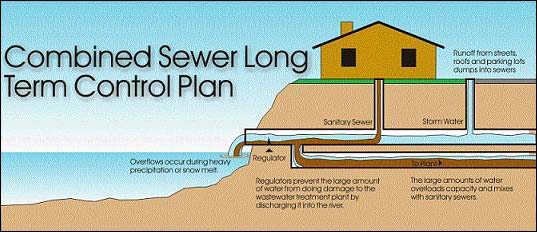
Downloadable Guides
- Student Handout: Guide to Understanding Combined Sewer Overflows (PDF)
- Student Brochure: Guide To Understanding Combined Sewer Overflows (PDF)
- Muncie Wastewater Treatment Facility handbook & brochure for students (PDF)
- Combined Sewer Overflow and Flood Stations Map of the city of Muncie (PDF)
- Muncie Sanitary District Long Term Control Plan Executive Summary & Implementation Schedule (PDF)
- Long Term Control Plan (LTCP) Approval Letter (PDF)
The Water Pollution Control Act passed by Congress in 1972 contained a wide range of requirements aimed at eliminating pollution of our streams and rivers. For many years, EPA and the Indiana Department of Environmental Management (IDEM) have concentrated on upgrading wastewater treatment plants. The focus now is concentrated on reducing and eliminating, if possible, pollution caused by overflows from combined sewers (CSO’s).
Combined Sewer Overflows (CSO’s)
A combined sewer conveys both sanitary waste and storm water through a single pipe system to a wastewater treatment facility. During heavy rainfall events, the flow in the combined sewer system exceeds the capacity of the wastewater treatment plant. To prevent overloading the wastewater treatment plant, a number of overflow points have been constructed on the combined system throughout Muncie. Muncie has 25 overflow points or CSO’s located along the river. Collectively, the sewer collection system and treatment plant are known as Publicly Owned Treatment Works (POTW). CSO discharges are point sources of pollution subject to the National Pollution Discharge Elimination System (NPDES) permit which means that Muncie is responsible for any polluted matter entering the river from the 25 CSO’s.
Water Quality Impacts From CSO’s
The greatest impacts of discharges from CSO’s are associated with bacteria in the untreated sewage. The maximum concentration of bacteria allowed in Indiana waters is 235 colonies E. coli/100 ml. of water, and will likely be exceeded with any CSO discharge. Other sources of pollutants discharged from CSO’s which have water quality impacts include industrial discharges to the sewer system, pollutants from urban storm water runoff, the dumping of automotive fluids and household chemicals down storm sewers and carelessly discarded litter. Under normal dry weather conditions, these materials will likely be transported to the treatment plant where they will be removed or treated. However, during heavy precipitation events, these same materials will most likely find their way to waters of the State.
Long Term Control Plan (LTCP)
The Muncie Sanitary District (MSD) is set to begin implementation of its Long Term Control Plan (LTCP) soon which will eventually eliminate Combined Sewer Overflows (CSO’s) into the White River and Buck Creek. Through the August 2011 State Judicial Agreement, the Indiana Department of Environmental Management (IDEM) approved the MSD’s LTCP. The plan calls for full separation of sanitary and combined sewers and sets in motion a 20 year, $160 million (2008 dollars) project consisting of approximately 84 miles of sewers and a wet weather treatment facility at the Water Pollution Control Facility (WPCF).
